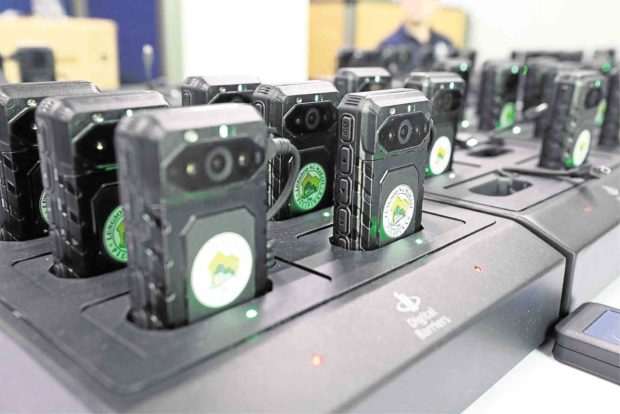
NEW EQUIPMENTTraffic enforcers of Makati City are now wearing these body cameras for their protection and as a deterrent to corruption. —PHOTO FROM MAKATI CITY GOV’T
A system for traffic enforcers of the Makati City Public Safety Department (PSD) to use body cameras became fully operational on Monday.
Officials said the cameras would be a deterrence to corruption and attacks.
The 180-degree cameras, according to Mayor Abby Binay, would help “in deterring bribery and corruption” and show if a traffic apprehension was done correctly.
Members of PSD’s predecessor, the so-called “Yellow Boys” of the Makati Public Safety Assistance Office, or Mapsa, had gained notoriety for cases of extortion with amounts ranging from P100 to P500 per traffic enforcer.
In September last year, a PSD traffic constable was shot dead while on duty on Osmeña Highway for allegedly being involved in corruption.
Death note
Before the motorcycle-riding suspects escaped, they left a note on the victim’s body saying in Filipino: “Extortionist Mapsa men, more will be killed!!! Do not emulate this man!!!”
Binay also said cases of motorists accusing enforcers of being abusive would be quickly confirmed or disproved by the body camera footage.
The body cameras would also help locate traffic enforcers for quicker deployment during emergencies, the mayor said.
The body camera and wireless transmission system were developed by British company Digital Barriers. The city government bought 180 cameras in March for P21 million.
Each camera has a built-in microphone, at least 32 GB built-in memory and 3G/4G internet connection, which can transmit live video to the Makati Command Control and Communications Center.
More features
When fully charged, the body cameras can record for up to eight hours straight, according to its specifications.
By pressing its “streaming alert button,” the wireless device can signal the operator at the command center to view live footage and take appropriate action during emergency case.
Videos from the cameras would be automatically downloaded into a secure web-based vault, which allows operators to manage, edit and share footage through computers, smart phones or tablets.
The cameras, securely attached to docking stations, can be pulled out only by tapping an RFID (radio frequency identification) card.

